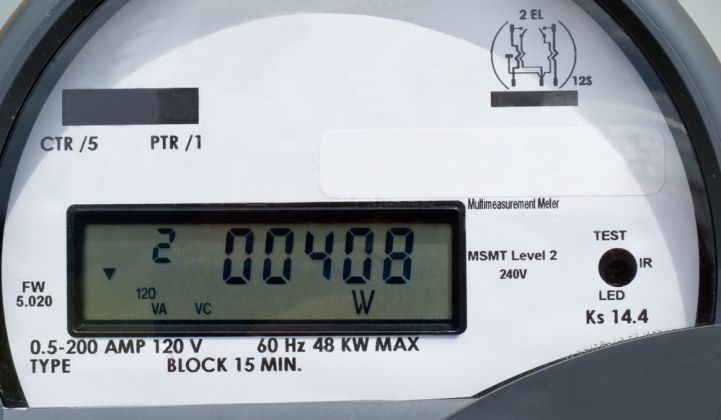A new paper from the nonpartisan Brookings Institution finds net energy metering is not a financial drain on the electric grid, as some utilities argue.
Brookings' review of literature on the costs and benefits of net metering shows that the economic benefits of net energy metering outweigh the costs of the program.
Even so, net metering is still insufficient, argue Brookings researchers. The policy doesn't address outdated volumetric rate structures or value distributed resources based on where they're needed most on the grid.
“This intense focus on net metering is actually missing the point,” said Devashree Saha, senior policy associate at Brookings and co-author of the paper. “It’s actually distracting about a bigger conversation we need to be having.”
To start, Brookings reviewed public utility commission, national laboratory, academic and think-tank reports and found that net metering “frequently benefits all ratepayers when all costs and benefits are accounted for.”

But the findings are not unanimous.
One outlier is the Louisiana Public Utility Commission, which found net metering customers do not pay the full cost of service. Saha said Louisiana did not consider some potential benefits that other methodologies included.
Many other studies have found more good than harm. For example, Mississippi found that net metering for solar PV would benefit all customers in all but one scenario. At high penetrations, the Mississippi regulators suggested a value-of-solar tariff, as Minnesota has enacted, to avoid cost shifting.
Even states that have slashed net metering have commissioned studies that suggest that higher fixed charges are not needed. The Brookings Institution points to a 2014 study commissioned by the Public Utilities Commission of Nevada that found net metering provided $36 million in benefits to all NV Energy customers.
In spite of those findings, the Nevada PUC tripled the fixed charges solar customers will pay over the next four years, and reduced the credit solar customers receive for net excess generation by three-quarters. The decision applies to all solar customers in the state.
While Nevada’s decision is particularly controversial, it also highlights the difficulty of bringing nuance to rate design as more distributed energy resources come on-line quickly.
“How do you unleash innovation and investment in distributed energy resources like solar in ways that are better for everyone?” asked Saha.
California and New York are two states that are trying to do just that. But the transition will take years.
Although net metering is a blunt instrument, it still works in the near term for most states. Many studies have found that the net-metering benefits to the grid are higher than the national average retail price of electricity of $0.12 per kilowatt-hour. One meta-analysis found the average value of solar across 11 studies was about $0.17 per kilowatt-hour.
“Until broad changes are made to the increasingly outdated and ineffective standard utility business model, which is built largely around selling increasing amounts of electricity, net-metering policies should be viewed as an important tool for encouraging the integration of renewable energy into states’ energy portfolios as part of the transition beyond fossil fuels,” the Brookings authors conclude.
And while much of the current focus is on net metering, solar is only one piece of the puzzle. True rate reform should take into account the various assets at the grid edge, including efficiency, electric vehicles and energy storage.
A recently commissioned study for New York regulators attempts to do that with its “full value tariff.” While most states are far away from the sort of overhaul New York is attempting, Brookings outlines three considerations that all regulators should consider beyond net metering:
- The unbundling of rates to specifically price energy, capacity and ancillary services
- A move away from volumetric block rates and toward time-based pricing for generation and consumption
- Pricing that more accurately compensates for location and technology-specific values
Decoupling is an important first step, argues Saha and co-author Mark Muro. “One would assume decoupling is a done deal,” said Saha, and yet it is not. Less than half of all states have decoupled the sale of kilowatt-hours from utility profits. “We have been talking about this for many, many years.”
Another recent report from Rocky Mountain Institute came to the same conclusion that basic volumetric rates and a singular focus on cost recovery simply do not work anymore.
The RMI report looked at rate design that would lower overall energy consumption and peak demand. RMI’s conclusions were similar to Brookings: mechanisms like demand charges, time-of-use rates or net metering are all just the first step to a more holistic overhaul of rate design.
“Ongoing attention is also needed to develop more sophisticated pricing structures and compensation mechanisms that fairly represent the benefits and costs of distributed energy resources, as well as customers’ use of the system,” the RMI study concludes.
The analysts at Brookings agree, and argue that all states should be considering such changes.
“We are no longer in a situation where you can wish away distributed energy resources,” said Saha. “At some point, you will need to grapple with a new situation where you will see significantly more penetration of solar and other distributed energy resources -- so let's start having that conversation now.”



